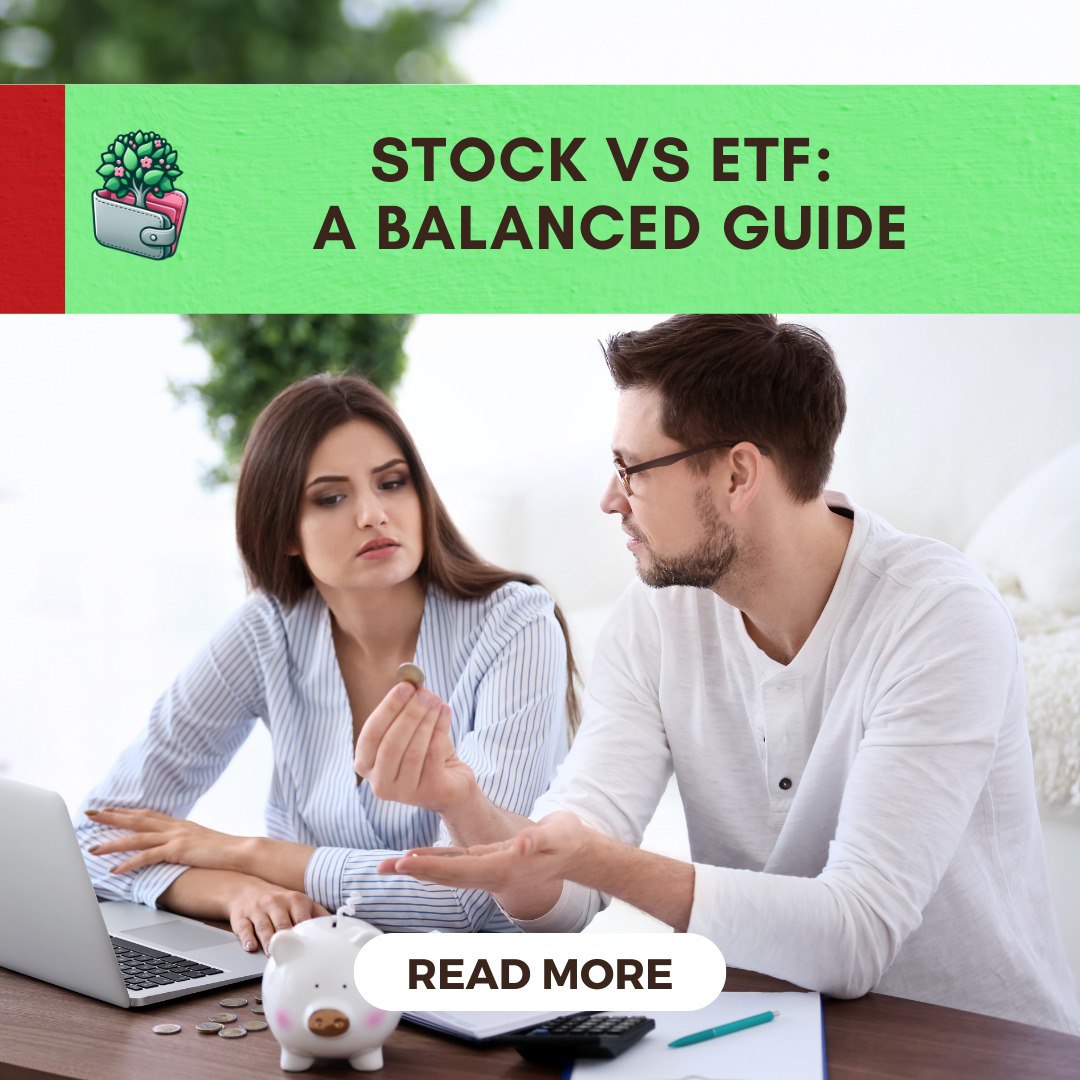Ever found yourself staring at the stock market, feeling like a deer caught in headlights? Don’t worry, you’re not alone! The world of investing can be a bit overwhelming, especially when it comes to deciding between stocks and ETFs.
But fear not, my fellow financial adventurers! In this guide, we’ll break down the difference between these two investment vehicles in a way that’s both informative and downright fun. So, grab your popcorn, sit back, and let’s dive into the exciting world of Stock vs ETF!

What are Stocks and ETFs?
Stocks offer the potential for higher returns but also come with higher risk. ETFs provide diversification and lower risk but may have lower potential returns. The best choice for you will depend on your individual investment goals, risk tolerance, and time horizon.
Definition of Stocks
Stocks represent fractional ownership in a company, allowing investors to participate in its potential growth. When you buy a stock, you’re essentially investing in the success of that company.
Think of stocks as shares in a business. Just like a shareholder in a company, you have a stake in its profits and losses. If the company does well, your stock value may increase. However, if the company performs poorly, your stock value may decline.
Key characteristics of stocks:
- Ownership: Represents ownership in a specific company.
- Volatility: Can be highly volatile, meaning their prices can fluctuate significantly in a short period.
- Management: Managed by the company’s management team.
- Costs: Typically involve higher transaction costs and fees compared to ETFs.
Definition of Exchange-Traded Funds (ETFs)
Exchange-Traded Funds (ETFs) are investment vehicles that pool money from investors to purchase a basket of assets, typically stocks, bonds, or a combination of both. They are designed to track a specific index or benchmark, such as the S&P 500 or the Nasdaq 100.
Think of ETFs as baskets of assets. Instead of buying individual stocks, you’re investing in a diversified portfolio of assets. This can help reduce risk and provide exposure to multiple sectors and industries.

Key characteristics of an exchange traded fund:
- Diversification: Offer diversification by investing in a basket of assets.
- Tracking: Designed to track a specific index or benchmark.
- Management: Passively managed, tracking a predetermined index.
- Costs: Generally have lower transaction costs and fees compared to stocks.
Similarities between Stocks and ETFs
Here is how stocks and ETFs are similar in some areas:
Exposure Opportunity
Both stocks and ETFs offer investors exposure to various asset classes, including domestic and international stocks, bonds, and commodities. This allows you to diversify your portfolio and potentially reduce risk by spreading your investments across different asset classes.
Trading Flexibility
Both stocks and ETFs can be traded on stock exchanges, providing you with the flexibility to buy and sell them during market hours. This means you can quickly adjust your investments based on changing market conditions or your personal financial goals.
Tax Efficiency
Both stocks and ETFs can be tax-efficient, but ETFs tend to be more tax-efficient than mutual fund trades. This is because ETFs are typically passively managed, which means they generate fewer taxable events compared to actively managed mutual funds.
Stock VS ETF: Key Differences
Now, let us look at where they differ.
Ownership Structure
- Stocks: A stock represents ownership in a single company. When you buy a stock, you become a part-owner of that specific company.
- ETFs: Represent ownership in a basket of assets, which can include stocks, bonds, or other securities. This means you’re investing in a diversified portfolio of assets rather than a single company.
Diversification
- Stocks: Can be volatile in the short term, but they can also provide long-term growth. However, investing in a single stock can be risky, as the performance of the company can significantly impact your investment.
- ETFs: Offer diversification by investing in a basket of assets. This helps to reduce risk and smooth out market fluctuations.

Cost Structure
- Stocks: Typically involve commissions when bought or sold. These commissions can add to the overall cost of your investment.
- ETFs: Have expense ratios, which are annual fees charged to cover the operating costs of the ETF. Most ETFs generally have low expense ratios than actively managed mutual funds.
When to Choose Individual Stocks
Individual stocks may be a suitable investment choice for experienced investors with a proven track record of making winning stock picks.
These investors may have the knowledge, expertise, and time to research and analyze individual companies, and they may be comfortable with the higher risk and potential reward associated with individual stock investing.
However, it’s important to note that individual stocks can be highly volatile, and there’s no guarantee of success. Even experienced investors can make mistakes. For new investors, ETFs are often a better choice due to their lower risk and diversification benefits, especially when considering specific budget categories.
When to Choose ETFs
ETFs are a good choice for investors who want diversification and a low-cost investment option. They can also be a good choice for investors who want to invest in a specific sector or industry without having to pick individual stocks. ETFs offer exposure to a wide range of asset classes and investment strategies, making them a versatile investment tool.
According to Investopedia, “One of the best ways to narrow ETF options is to utilize an ETF screening tool with criteria such as trading volume, expense ratio, past performance, holdings, and commission costs.”
When Both Make Sense
Investing in both stocks and ETFs can be a winning strategy, especially for intermediate investors. This approach can allow you to increase your few individual stocks exposure as you become more comfortable with the process while still maintaining diversification through your ETF investments.
ETFs vs Mutual Funds
ETFs and mutual funds are both popular investment vehicles, but they have some key differences.
One of the main differences is in how they are traded and priced. ETFs can be bought and sold throughout the trading day, while mutual funds are priced only at the end of the trading day. This means that you can buy or sell an ETF at its current market price, while you can only buy or sell a mutual fund at its net asset value (NAV), which is calculated at the end of each trading day.

Another key difference is in the level of control you have over the price of your trade. ETFs offer more control over the price of your trade, as you can buy or sell them at their current market price. They are unlike mutual funds, which do not offer the same level of control, as you can only buy or sell them at the NAV.
Finally, there are differences in the investment minimums. ETFs generally have lower investment minimums, making them more accessible to investors with smaller amounts of money to invest. Mutual funds, on the other hand, often have a flat dollar amount minimum, which can be higher than the minimum for ETFs.
Which is Right for You?
The choice between ETFs and mutual funds depends on your individual investment goals, risk tolerance, and time horizon.
ETFs are a good option for a new or intermediate investor, or those with a low or moderate risk tolerance. They offer diversification, low costs, and the ability to trade throughout the day.
Mutual funds can be a good option for investors who want to invest in a specific sector or industry. They offer professional management and can be a good choice for investors who prefer a hands-off approach to investing.
Pros and Cons of ETFs
Let us take a look at the pros and cons of ETFs.
Pros
- Diversification: ETFs offer diversification by investing in a basket of assets, which can help to reduce risk and smooth out market fluctuations.
- Lower Cost: ETFs typically have lower operating expense ratios (OERs) than actively managed mutual funds, which can translate into higher returns over time.
- Trading Flexibility: ETFs can be traded on stock exchanges, allowing you to buy and sell them during market hours. This provides you with greater flexibility and control over your investments.
Cons
- Trading Commissions: ETFs typically involve trading commissions, which can eat into your returns, especially if you trade frequently.
- Operating Expense Ratio (OER): ETFs have an OER, which is an annual fee charged to cover the operating costs of the ETF. While ETFs generally have lower OERs than actively managed mutual funds, they still can have an impact on your returns over time.
How to Invest in ETFs
There are various types of ETFs, including those that track a specific index, sector, or asset class. For example, some ETFs track the S&P 500 Index, while others focus on specific sectors such as technology or healthcare. ETFs can be used to gain exposure to specific sectors or industries without having to pick individual stocks.
ETFs, or Exchange-Traded Funds, are investment funds that trade on stock exchanges. They offer a way to invest in a basket of securities, such as stocks, bonds, or commodities, without having to buy each individual asset.
Research ETFs
Identify ETFs that match your investment objectives and risk tolerance. Consider factors such as the ETF’s underlying assets, expense ratio, and performance history.
Open a brokerage account
Choose a reputable online broker and open an account.
Fund your account
Deposit the amount you want to invest into your brokerage account.
Purchase ETFs:
Use your brokerage account to buy the desired ETFs.
Monitor your investments
Keep track of your ETF holdings and their performance. Consider rebalancing your portfolio as needed.
Supply:
- ETFs are widely available and can be purchased through most online brokers or financial advisors.
Tools:
- Online Brokerage Account
- Research Tools
Materials: Investment Capital

Most Popular ETFs for Investors
Some of the most popular ETFs for investors include:
- S&P 500 ETFs: These ETFs track the S&P 500 Index, which is a broad-based index that includes 500 of the largest companies in the United States.
- Dow Jones Industrial Average ETFs: These ETFs track the Dow Jones Industrial Average, which is a price-weighted index of 30 large, well-known companies.
- Nasdaq Composite Index Funds ETFs: These ETFs track the Nasdaq Composite Index, which is a technology-heavy index that includes most of the companies listed on the Nasdaq Stock Exchange.
How to Buy ETFs
To invest in ETFs, you’ll need to open an account with an investment broker or robo-advisor. Once you’ve opened an account, you’ll need to fund it with your investment capital. Then, you can start choosing ETFs to invest in.
According to State Street Global Advisors, “Many companies periodically pay out a portion of their profits to shareholders in the form of dividends. Similarly, ETFs may receive pay dividends from stocks they hold, which are in turn paid to investors who own shares of the ETF.”
Building a Portfolio with Stocks and ETFs
Stocks and ETFs offer distinct advantages for investors seeking to build a well-diversified portfolio. While stocks can potentially deliver exceptional returns over the long term, they are also subject to market volatility.
ETFs, on the other hand, offer diversification and can provide exposure to a broad range of asset classes, making them a valuable tool for investors looking to mitigate risk.
According to Bankrate, “Though it’s possible to find the big winners among individual stocks, you have strong odds of doing well consistently with ETFs. Of course, you can blend the two methods as well, getting the benefits of a diversified portfolio with the potential extra juice from a few individual stocks on the side, if you want to try your skill.”
By combining stocks and ETFs, investors can create a portfolio that balances the potential for high returns with the benefits of diversification.
To Wrap Up
ETFs offer diversification and can be traded on an exchange like stocks, making them a popular choice for investors. Stocks can be volatile in the short term, but they can also provide long-term growth. Investing in both stocks and ETFs can be a winning strategy, especially for intermediate investors.
ETFs are a great option for many investors, especially those who are new to the market or want to diversify their portfolio. Stocks can be a great investment in some circumstances, but ETFs are often a better choice for new investors.


